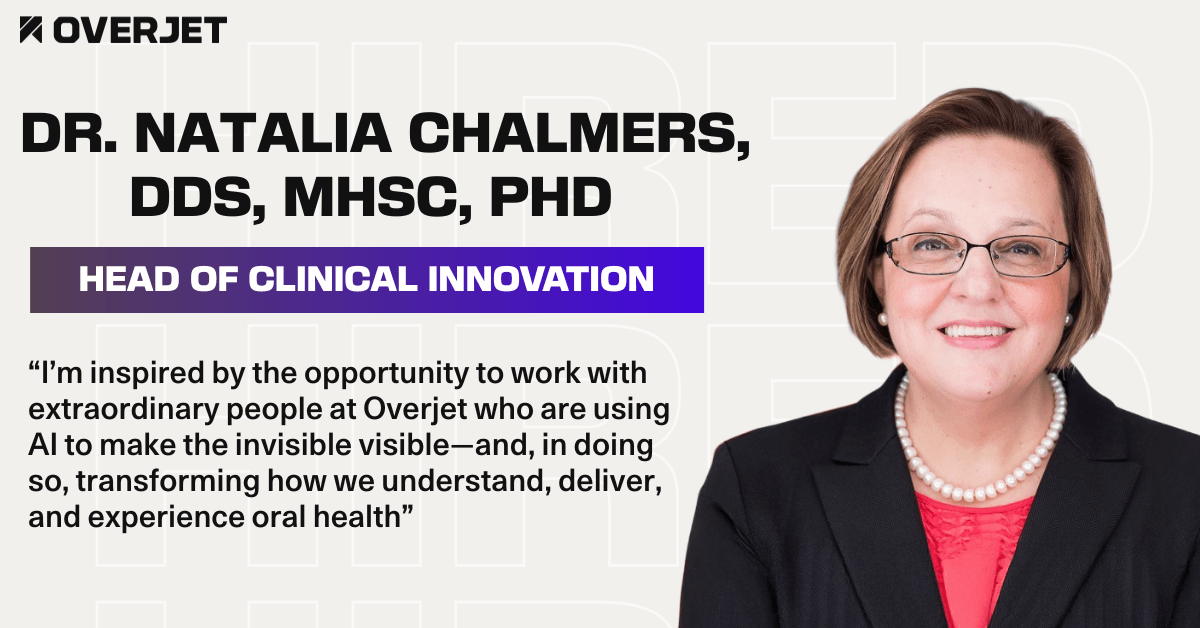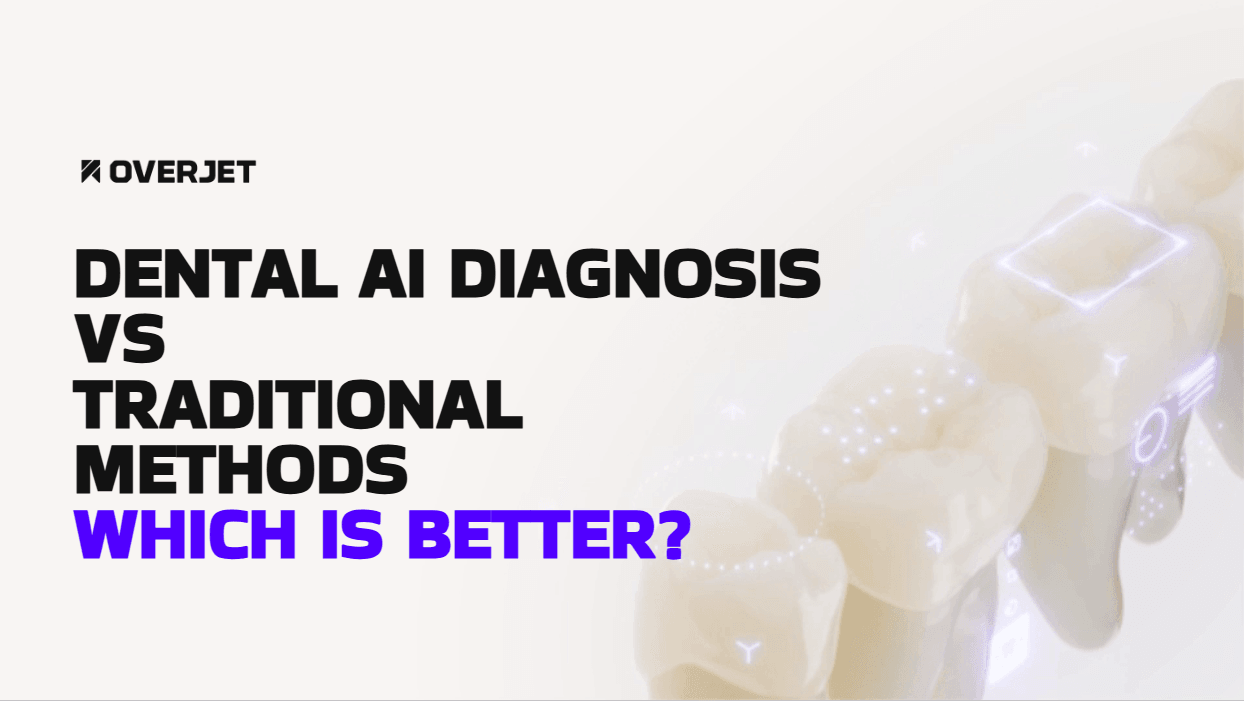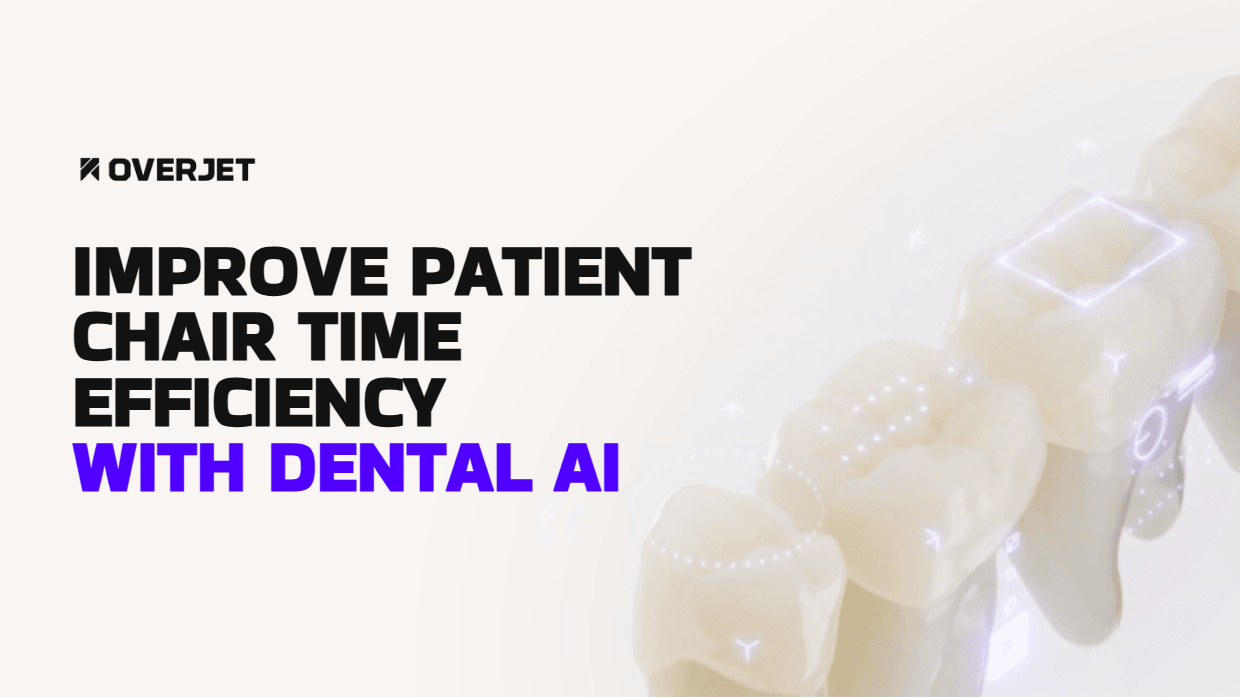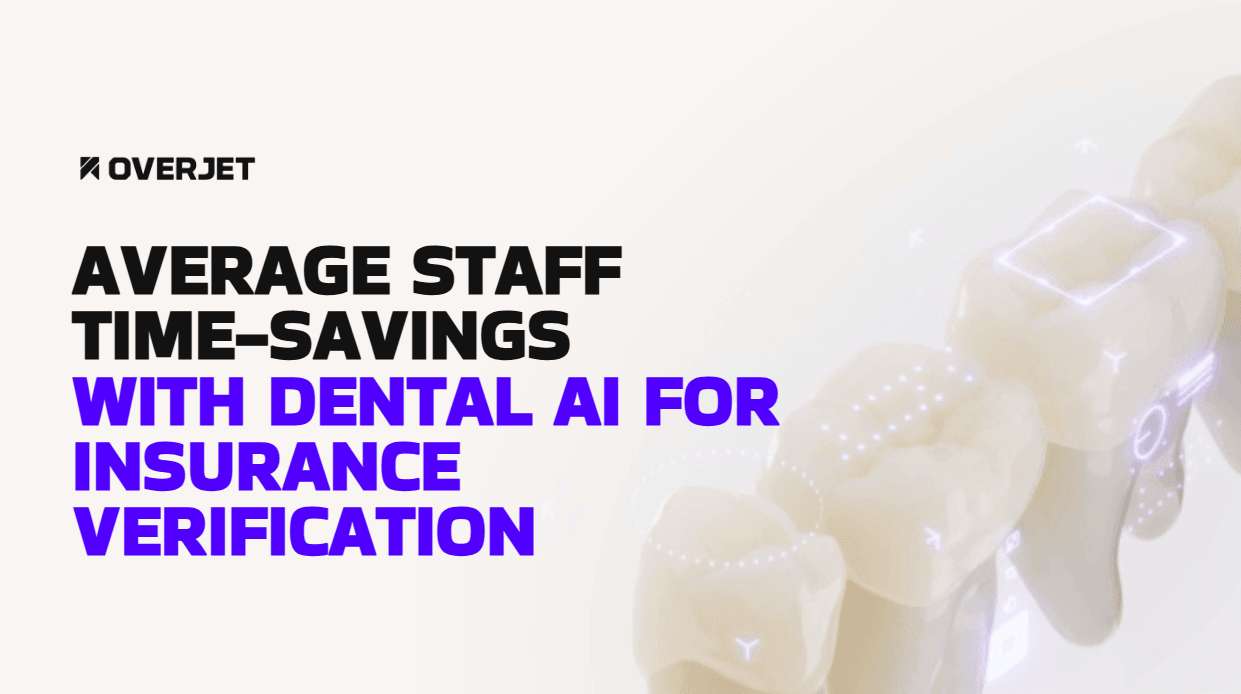Insurance verification determines whether your practice gets paid on time or spends months chasing down denied claims. Most dental teams still waste hours on hold with insurance carriers, only to receive incomplete benefit information that leads to patient disputes and revenue loss.
This guide walks through the complete verification workflow, from data collection and eligibility checks to spotting hidden policy limitations and implementing AI dental insurance verification automation that reduces verification time from 20 minutes to under 60 seconds.
Explore Overjet's Dental AI Software
Definition and Scope of Dental Insurance Verification
Dental insurance verification confirms a patient’s coverage details, benefit levels, and financial responsibility before treatment begins. This process goes beyond checking if insurance is active; it involves gathering specific information about annual maximums, deductible status, coverage percentages, waiting periods, and plan exclusions that affect treatment.
The verification workflow starts at initial patient contact and continues through treatment planning and claim submission. When practices verify benefits thoroughly, they establish clear financial expectations, prevent surprise bills, and reduce claim denials.
Why Manual Verification Fails in 2025
Manual verification creates bottlenecks that slow down both administrative work and patient care. Staff members often spend 15 to 20 minutes per verification call, with hold times sometimes exceeding 30 minutes.
The problems compound quickly:
Error rates: Manual data entry produces mistakes that lead to claim denials and rework
Incomplete information: Phone representatives often provide outdated or partial benefit details
Staff burnout: Repetitive verification tasks contribute to administrative fatigue and turnover
Inconsistent records: Different team members document information in varying formats
Outdated data: Benefits change frequently, yet manual processes rarely catch mid-month policy updates
Beyond the time investment, practices face real financial consequences. Verification errors directly contribute to denied claims and lost revenue, while staff productivity suffers from constant task-switching between phone calls and patient interactions.
Essential Data Fields for Eligibility Checks
Accurate verification depends on collecting comprehensive information across several categories. Missing even one data point can result in incomplete benefit understanding and unexpected patient balances.
Member and Subscriber Identifiers
Start with the primary member ID exactly as it appears on the insurance card, including any prefix letters or suffix numbers. You’ll also need the subscriber’s full legal name, their relationship to the patient, and the patient’s date of birth for identity verification. Many carriers require the subscriber’s date of birth as well, particularly when dependents receive treatment.
Plan and Group Numbers
Group numbers identify the specific employer or organization sponsoring the insurance plan. This number determines benefit levels and coverage rules; two patients with the same carrier might have drastically different coverage based solely on their group number. Plan type identification matters too, as PPO, HMO, indemnity, and discount plans each have different network participation requirements and reimbursement rates.
Annual Maximums and Deductibles
Document the plan’s annual maximum benefit amount, how much has been used year-to-date, and when the benefit year resets. For deductibles, record the individual amount, family deductible if applicable, remaining balance, and which procedure categories apply toward the deductible. Some plans exclude preventive care from deductible requirements, while others apply deductibles universally.
Waiting Periods and Frequency Limits
Waiting periods commonly affect major services like crowns, bridges, and dentures for newly enrolled members. The restrictions typically range from six to twelve months and can significantly impact treatment timing. Frequency limitations govern how often patients can receive specific procedures. Most plans allow two cleanings per calendar year, while X-rays face restrictions like one full-mouth series every three to five years.
Coordination of Benefits Details
When patients carry dual coverage, establish which plan is primary and which is secondary based on the birthday rule or other coordination guidelines. Document each plan’s coordination of benefits clause, as some plans reduce benefits when secondary coverage exists.
Step-by-Step Verification Workflow
A structured verification workflow reduces errors and creates consistency across your team. Each step builds upon the previous one.
1. Collect Patient and Plan Information
Begin at scheduling or check-in by scanning both sides of the patient’s insurance card and capturing demographic information through digital forms. Verify dependent status for patients under 26, as many remain on parental plans but might not have current card copies.
2. Access Real-Time Eligibility Portals
Log into the carrier’s provider portal or use clearinghouse services that aggregate multiple payers into a single interface. Navigate to the eligibility section and input the patient identifiers collected in step one. Real-time responses typically appear within seconds, though some carriers still require 24 to 48 hours for detailed benefit breakdowns.
3. Confirm Benefit Levels and Remaining Maximums
Calculate the remaining annual maximum by subtracting year-to-date usage from the total benefit amount. Document coverage percentages for each procedure category, preventive typically covers at 100%, basic restorative at 80%, and major services at 50%, though variations exist.
4. Check Pre-Authorization Requirements
Identify which planned procedures require pre-authorization versus pre-determination. Pre-authorization is mandatory approval before treatment, while pre-determination is an optional benefit estimate. Common procedures requiring pre-authorization include crowns, bridges, implants, periodontal surgery, and orthodontics.
5. Document Findings in the Practice Management System
Record all verification details in your practice management software using standardized fields and consistent formatting. Include the verification date, representative name or reference number, and specific benefit details for planned procedures. Attach any electronic benefit documents or portal screenshots to the patient record.
6. Communicate Estimates to the Patient
Present financial information clearly by breaking down insurance coverage, patient responsibility, and payment options. Use visual treatment plans that show procedure costs, insurance estimates, and out-of-pocket amounts. Obtain written acknowledgment that the patient understands their financial responsibility.
7. Re-Verify Before the Appointment
Insurance status changes frequently due to employment transitions, plan modifications, or coverage terminations. Re-verify benefits if more than 30 days have passed since initial verification, if the patient reports any insurance changes, or before major treatment begins.
Spotting Hidden Clauses and Limitations
Insurance policies contain numerous restrictions that aren’t immediately apparent during basic eligibility checks. Identifying limitations early prevents patient surprises and collection challenges.
Missing Tooth Clauses
Missing tooth clauses exclude coverage for replacing teeth that were missing before the patient’s insurance effective date. A patient who lost a tooth five years ago won’t receive implant or bridge coverage under a policy purchased last month. The clause applies even if the patient had continuous coverage under a different carrier.
Downgrades and Alternate Benefits
Carriers frequently substitute less expensive alternatives when multiple treatment options exist for the same condition. A posterior composite filling might be downgraded to amalgam reimbursement rates, even though you placed tooth-colored material. Similarly, insurance might approve a crown but reimburse at the rate for a large filling.
Least Expensive Alternative Treatment Rules
LEAT policies allow carriers to base reimbursement on the most economical clinically acceptable treatment, regardless of the procedure you actually perform. If a removable partial denture could theoretically address missing teeth, the carrier might limit payment to that amount even when you place a fixed bridge.
Documentation and Compliance Updates for 2025
Regulatory changes continue to reshape verification workflows and documentation requirements. Staying current with updates protects your practice from compliance violations and audit penalties.
HIPAA and State Privacy Changes
Federal privacy rules now require enhanced documentation of patient consent for insurance verification communications. Several states have implemented stricter data protection standards that exceed HIPAA minimums, particularly regarding electronic transmission of protected health information.
CDT 2025 Code Impacts
Updated procedure codes affect how you verify benefits and submit claims. New codes for specific procedures require updated benefit verification questions to ensure accurate coverage determination. Deleted or revised codes might cause confusion if insurance systems haven’t updated their databases.
Payer Audit Readiness
Insurance carriers increasingly audit provider verification documentation to identify improper billing patterns. Maintain verification records for at least seven years, including dates of verification, methods used, representative names, and specific benefit details confirmed.
Automation and AI Options for Dental Practices
Technology solutions eliminate manual verification bottlenecks while improving accuracy and staff satisfaction. Overjet uses advanced AI technology to quickly check insurance eligibility and match benefits. Overjet’s AI platform addresses workflow challenges by automating insurance verification alongside clinical documentation and claim preparation…
Eligibility APIs and Clearinghouses
Real-time eligibility checking through electronic interfaces connects your practice management system directly to carrier databases. APIs return benefit information within seconds, eliminating phone calls and hold times. Clearinghouses aggregate multiple payers into a single connection point, reducing the technical complexity of maintaining individual carrier relationships.
AI-Powered Benefit Mapping
Artificial intelligence interprets complex benefit structures and identifies coverage gaps that human reviewers might miss. Overjet’s automated verification capabilities analyze policy documents, cross-reference procedure codes with benefit categories, and flag potential issues like missing tooth clauses or frequency limitations before treatment planning begins. The system learns from historical claim adjudications to predict coverage outcomes with increasing accuracy.
Integrated Patient Communication Tools
Automated systems generate patient-friendly benefit summaries and financial estimates without manual intervention. Overjet integrates verification data with clinical AI findings to create comprehensive treatment plans that include both clinical rationale and financial transparency.
Book a demo to see how Overjet automates verification workflows while improving clinical accuracy.
Key Performance Metrics and ROI Benchmarks
Measuring verification effectiveness requires tracking specific metrics that correlate with financial and operational outcomes. While automation can significantly reduce verification time and administrative workload, actual time savings and performance improvements may vary by practice. For the most current metrics and case studies, consult verified Overjet sources or request performance data directly from Overjet.
Metric | Manual Process | Automated Process |
Average verification time | 15-20 minutes | 30-60 seconds |
Staff hours per week | 20-30 hours | 2-5 hours |
Days in AR | 45-60 days | 28-35 days |
Eligibility Hit Rate
Successful verification percentage measures how often your process obtains complete benefit information on the first attempt. Target rates above 95% indicate effective data collection and system integration.
First-Pass Claim Acceptance
Clean claim rates directly correlate with verification thoroughness. When verification captures all necessary benefit details, the claims process proceeds without additional documentation requests or denials. Overjet users typically see first-pass acceptance rates improve within the first quarter of implementation.
Staff Time Saved Per Verification
Calculate the difference between manual verification duration and automated processing time, then multiply by your verification volume. A practice handling 50 verifications weekly saves approximately 12 to 16 staff hours by eliminating phone calls and manual data entry.
Days in Accounts Receivable
Accurate verification reduces collection cycles by preventing claim denials and patient balance surprises. Practices with robust verification workflows typically maintain AR days in the 30 to 40 range, while gaps in verification often push days beyond 60.
Future Trends Shaping Verification Beyond 2025
Industry developments and regulatory mandates are transforming how practices access and utilize benefit information.
Real-time benefit quoting standards: Industry consortia are developing standardized protocols for instant benefit verification at the point of treatment planning
Payer interoperability mandates: Federal regulations require insurance carriers to provide electronic access to benefit information through standardized APIs
Predictive analytics for coverage gaps: AI systems will analyze historical claim patterns to predict coverage issues before treatment begins
Patient-controlled benefit data: Emerging models give patients direct access to their benefit information through mobile apps
Elevate Verification Accuracy With Overjet AI
Overjet transforms verification from an administrative burden into a strategic advantage by integrating automated benefit checking with clinical AI. The platform connects directly to carrier systems, retrieves real-time eligibility data, and maps benefits to specific procedures in your treatment plan.
When Overjet’s clinical AI detects conditions requiring treatment, the system automatically verifies coverage and generates patient estimates that include both clinical rationale and financial transparency. The platform’s learning algorithms continuously improve coverage predictions based on actual claim outcomes, creating increasingly accurate benefit estimates over time.
Ready to See Overjet's Dental AI in Action?
Frequently Asked Questions (FAQs)
How long does automated dental insurance verification implementation take?
Most practices complete automated verification system integration within two to four weeks, including staff training and workflow adjustment periods. Implementation speed depends on your existing practice management system compatibility, staff technical proficiency, and the complexity of your payer mix.
Can AI verification tools integrate with existing practice management systems?
Modern AI verification platforms connect seamlessly with most practice management systems through standard APIs and data exchange protocols. Overjet integrates with leading dental software platforms, allowing verification data to flow directly into your existing workflows without duplicate data entry or system switching.
What does real-time dental eligibility verification cost per transaction?
Real-time verification costs typically range from minimal per-transaction fees to monthly subscription models, based on practice volume and feature requirements. Many practices find that the reduction in claim denials and staff time savings generates positive ROI within the first 90 days.









